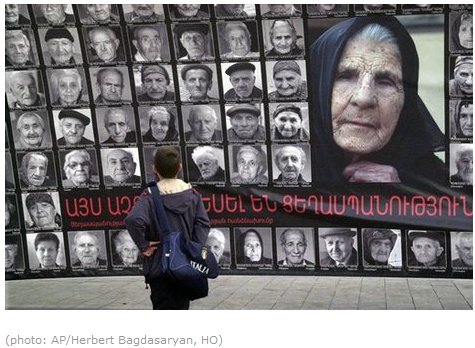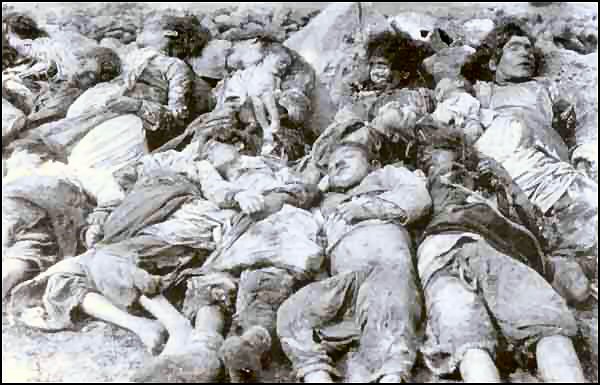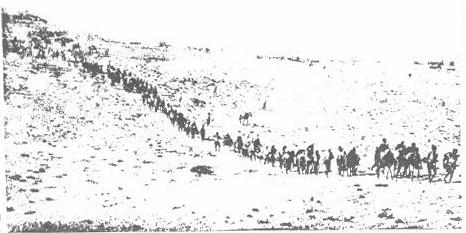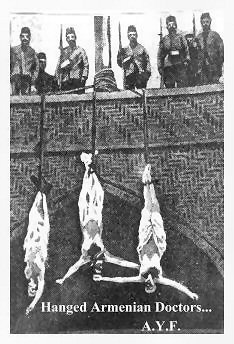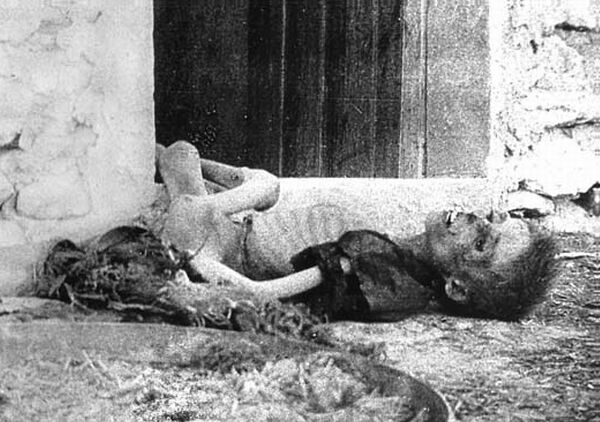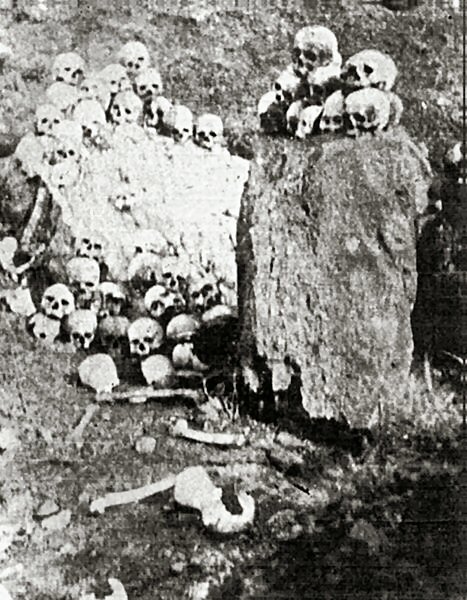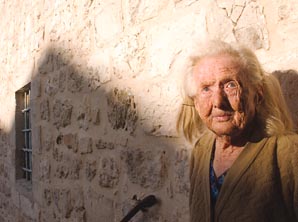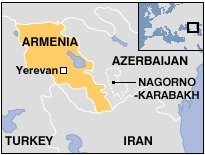|
Before the Nazi's
slaughtered 6 million Jews, before the Khmer Rouge killed 1.7
million of their fellow Cambodians, before Rwandan Hutus killed
800,000 ethnic Tutsis, the Armenians of Turkey endured mass
slaughter at the hands of the Ottoman Turks. The centuries of
Turkish rule reduced Asia Minor, the epicenter of western
civilization and Christendom, into a bloody
Islamic
cesspool which culminated in a genocide by Turks against Armenian
and Greek Christian populations.
The Armenian Genocide,
occurred when 2 million Armenians living in Turkey were eliminated
from their historic homeland through forced deportation and
massacres by the Turks. As Turkish authorities forced them out
of eastern Turkey, Armenians say they lost 1.5 million people in
1915-23, during and after World War I. Turkey says the death count
is inflated and that the deaths were a result of civil unrest.
To this day Turkey denies the Armenian genocide, but history cannot
be hidden or rewritten.
Even Adolf Hitler
cited the killing of the Armenians as a precedent for his own
slaughter of the Jews two decades later.
"Kill without mercy!"
the Nazi leader told his military on the eve of the Holocaust. "Who,
after all, speaks today of the annihilation of the Armenians?"
See reference for this statement by Hitler at the very bottom.
|
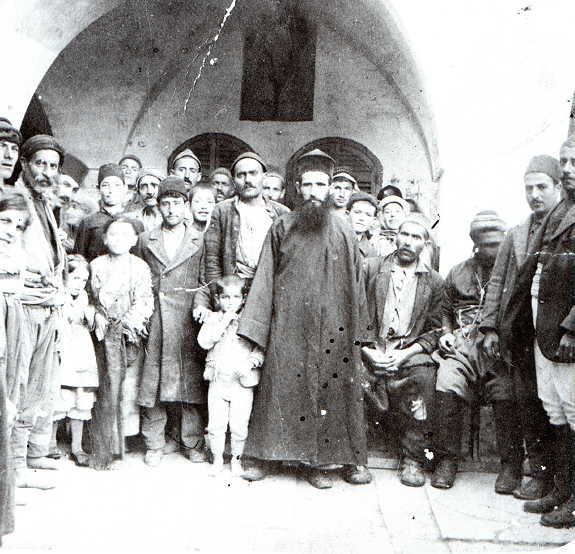 |
|
Armenians |
For three thousand
years, a thriving Armenian community had existed inside the vast
region of the Middle East bordered by the Black, Mediterranean and
Caspian Seas. The area, known as Asia Minor, stands at the
crossroads of three continents; Europe, Asia and Africa. Great
powers rose and fell over the many centuries and the Armenian
homeland was at various times ruled by Persians, Greeks, Romans,
Byzantines, Arabs and Mongols. Following the advent of
Christianity, Armenia became the very first nation to accept it as
the state religion. In 301 A.D., Armenia became the first nation to
officially declare itself Christian. A golden era of peace and prosperity followed
which saw the invention of a distinct alphabet, a flourishing of
literature, art, commerce, and a unique style of architecture. By
the 10th century, Armenians had established a new capital at Ani,
affectionately called the "city of a thousand and one churches."
In the eleventh century, the first Turkish (Seljuk Turks) invasion of the Armenian
homeland occurred. The Muslim Turkish king, Alp Arslan invaded
Armenia, and sacked its capital city Ani in 1064 A.D. This began several hundred years of rule by
Muslim Turks. By the sixteenth century, Armenia had been absorbed
into the vast and mighty Ottoman Empire. At its peak, this Turkish
empire included much of Southeast Europe, North Africa, and almost
all of the Middle East.
But by the 1800s the
once powerful Ottoman Empire was in serious decline. For centuries,
it had spurned technological and economic progress, while the
nations of Europe had embraced innovation and became industrial
giants. Turkish armies had once been virtually invincible. Now, they
lost battle after battle to modern European armies.
As the Ottoman empire gradually disintegrated, formerly subject
peoples including the Greeks, Serbs and Romanians achieved their
long-awaited independence. Only the Armenians and the Arabs of the
Middle East remained stuck in the backward and nearly bankrupt
empire, now under the autocratic rule of Sultan Abdul Hamid II. Ottoman
misrule had made the Armenians, a prosperous minority despite its
political disadvantages, sympathetic to Russia. Between 1894
and 1896 over 100,000 inhabitants of Armenian villages were
massacred during widespread pogroms conducted by the Sultan's
special regiments.
Sultan Abdul-Hamid II
known in history as the "Red Sultan" carried out a series of
massacres of the Armenian population of the Ottoman Empire. The
worst of the massacres occurred in 1895, resulting in the death of
100,000 to 300,000 civilians, and leaving tens of thousands
destitute. Most of those killed were men. In many towns, the
central marketplace and other Armenian-owned businesses were
destroyed, usually by conflagration.
The Young Turks were
the perpetrators of the Armenian Genocide. The Young Turk Movement
emerged in reaction to the absolutist rule of Sultan Abdul-Hamid (Abdulhamit)
II (1876-1909). With the 1878 suspension of the Ottoman
Constitution, reform-minded Ottomans resorted to organizing overseas
or underground. The backbone of the movement was formed by young
military officers who were especially disturbed by the continuing
decline of Ottoman power and attributed the crisis to the absence of
an environment for change and progress.
At the center of the Young Turk Revolution stood the Committee of
Union and Progress (CUP) formed in 1895. Its members came to be
known as Ittihadists or Unionists. The most ideologically committed
party in the entire movement, the CUP espoused a form of Turkish
nationalism which was xenophobic and exclusionary in its thinking.
The CUP seized power in a coup d'etat in January 1913. Armenians in
Turkey were delighted with this sudden turn of events and its
prospects for a brighter future. Both Turks and Armenians held
jubilant public rallies attended with banners held high calling for
freedom, equality and justice. But things were not as they
seemed to those jubilant Armenians.
Along with the Young
Turk's newfound "Turanism" there was a dramatic rise in Islamic
fundamentalist agitation throughout Turkey. Christian Armenians, who
had always been one of the best-educated and wealthy communities
within the old Turkish Empire were once again branded as infidels
(non-believers in Islam). Young Islamic extremists, staged
anti-Armenian demonstrations which often led to violence. During one
such outbreak in 1909, two hundred villages were plundered and over
30,000 persons massacred in the Cilicia district on the
Mediterranean coast. Throughout Turkey, sporadic local attacks
against Armenians continued unchecked over the next several years.
To consolidate Turkish rule in the remaining territories of the
Ottoman Empire and to expand the state into the so-called Turanian
lands in the east, most held by Iran and Russia, the CUP devised in
secret a program for the extermination of the Armenian population.
From the viewpoint of its ideology and its new and ambitious foreign
policy, the Armenians represented a completely vulnerable population
straddling an area of major strategic value for its Pan-Turanian
goals. The traditional historic homeland of Armenia lay right
in the path of their plans to expand eastward. And on that land was
a large population of Christian Armenians totaling some two million
persons, making up about 10 percent of Turkey's overall population.
Somewhat surprisingly to many, Armenians and Turks lived in relative
harmony in the Ottoman empire for centuries. Armenians were
known as the "loyal millet". During these times, although Armenians
were not equal and had to put up with certain special hardships,
they were pretty well accepted and there was relatively little
violent conflict.
During World War I,
the Ottoman Turks, were allied with Germany and Austria-Hungary, and
an enemy of czarist Russia. The Armenians fought with the
Russians, and both the Germans and Ottomans considered Turkey's
Armenian citizens as "the enemy within". When the
world's attention fixed upon the battlegrounds of France and
Belgium, the Turks decided it was time to solve their "Armenian
Problem" by exterminating them. The cover the Islamic Turks used was
the lie that during the war that Armenians had been, for their own
safety, evacuated to strategic hamlets so they would not be caught
between Turkey and Russia.
|
Echoes of
the Jewish Holocaust |
| The remarkable thing
about the following events is the virtually complete
cooperation of the Armenians. For a number of reasons
the Armenians did not know what was planned for them and
went along with "their" government's plan to "relocate
them for their own good". |
The Turks began by
disarming the entire Armenian population under the pretext that the
people were naturally sympathetic toward Christian Russia who Turkey
was at war with. First the Armenians were asked to turn in hunting
weapons for the war effort. Every last rifle and pistol was forcibly seized,
with severe penalties for anyone who failed to turn in a weapon.
|
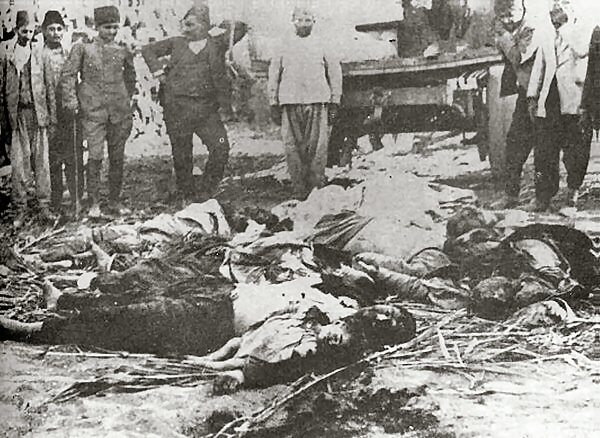 |
|
Turks seem to rejoice watching a massacred Christian
family. Even babies were tortured and massacred. |
Mass deportations of the the civilian Armenian population was
carried out in the spring and summer of 1915 and were completed by
the fall, the systematic slaughter of the Armenians had started
earlier with the murder of the 40,000 able-bodied males already
drafted into the Ottoman armed forces. These able bodied
Armenian men were then drafted and told it was to help Turkey's
wartime effort. In the fall and winter of
1914, all of the Armenian soldiers had their weapons taken from them
before they were put into slave labor battalions, building roads.
Under the brutal work conditions they suffered a very high death
rate. Those soldiers who survived were shot outright.
By stealing the
movable and immovable wealth of the Armenians, the CUP looked upon
its policy of genocide as a means for enriching its coffers and
rewarding its cohorts.
In 1908, Bulgaria was
finally liberated from Turkish rule by Russia. In that same
year, the "Young Turk Revolution" began. It was led by three
young Turkish military officers: Mehmed Talat Pasha, Ismail
Enver and Ahmed Djemal, were responsible for these policies.
These three formed the governing triumvirate which had concentrated
dictatorial powers in their own hands after the January 1913 coup.
They divided the governance of the Ottoman Empire among themselves.
Soon these three dictators began promoting the idea of a homogeneous
Turkish state of one race and one religion (Islam). They
decided to expel or exterminate all non-Muslim, non-Turkish ethnic
groups, specifically the Greek and Armenian Christians. During
World War I the western world was focused on Germany, France and
England. This provided Turkey with the perfect opportunity to
carry out their premeditated massacre of its ethnic minorities.
Enver was a young
26 year old military hero who married into the Ottoman dynasty. He
provided the most public face of the CUP. As Minister of War he
coordinated the buildup of the Turkish armed forces with German
financial, logistical, and planning support. In an ill-conceived
plan of attack, he precipitated land warfare against Russia in the
Caucasus in the dead of winter. His December 1914 campaign cost an
entire army lost in a period of four weeks. In his capacity as the
Deputy Commander-in-Chief, Enver exercised ultimate control over the
Ottoman armies which carried out major atrocities, first in 1915 and
then with renewed vigor when Turkish forces broke the Russian line
in 1918 and invaded the Caucasus. The forces under the command of
Enver's brother, Nuri, and uncle, Halil, spread devastation through
Russian Armenia and carried out massacres of Armenians all the way
to Baku. Talaat was the Minister of the Interior in Istanbul who ran
the government for a figurehead grand vizier. Talaat was the
mastermind of the Armenian Genocide and coordinated the various
agencies of the Ottoman government required for the deportation,
expropriation, and extermination of the Armenians.
The decision of Genocide:
The decision to
annihilate the entire Armenian population came directly from the
ruling triumvirate of ultra-nationalist Young Turks. The actual
extermination orders were transmitted in coded telegrams to all
provincial governors throughout Turkey. Armed roundups began on the
evening of April 24, 1915, as 300 Armenian political leaders,
educators, writers, clergy and dignitaries in Constantinople
(present day Istanbul) were taken from their homes, briefly jailed
and tortured, then hanged or shot. In May of 1915
claiming that the Armenians were untrustworthy, the Minister of
Internal Affairs (Talaat) ordered their deportation to relocation
centers in the deserts of Syria and Mesopotamia.
|
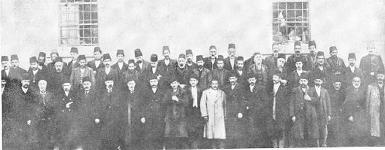 |
|
Armenians from
Kesaria in front of jail one hour before all were killed |
Next, there were mass arrests of Armenian adult men and teenagers throughout the country
by Turkish soldiers, police agents and bands of Turkish volunteers.
The men were tied together with ropes in small groups then taken to
the outskirts of their town and shot dead or bayoneted by death
squads. Local Turks and Kurds armed with knives and sticks often
joined in on the killing.
|
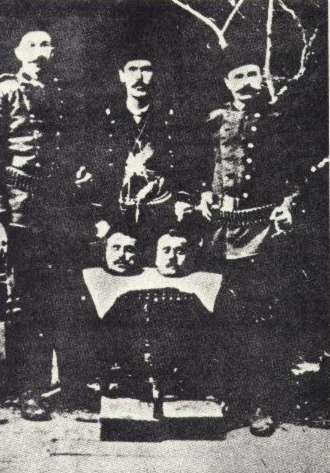 |
|
Turkish soldiers posing proudly with the
decapitated heads of Armenian community
leaders, 1915 |
Then it was the turn
of Armenian women, children, and the elderly. On very short notice,
they were ordered to pack a few belongings and be ready to leave
home, under the pretext that they were being relocated to a
non-military zone for their own safety. They were actually being
taken on death marches heading south toward the Syrian Desert.
The death marches would lead across Anatolia and the purpose was
clear. The Armenians were being raped, starved, dehydrated, murdered
and kidnapped along the way. Those who miraculously survived
the march would arrive to this bleak desert only to be killed upon
arrival or to somehow survive until a way to escape the empire was
found. Countless survivors and refugees scattered throughout
the Arab provinces and Transcaucasia were to die of starvation,
epidemic, and exposure. Even the memory of the Armenian nation was
intended for obliteration; churches, and monuments were desecrated,
and small children snatched from their parents, were renamed and
farmed out to be raised by Turks. Many girls and younger women were
seized from their families and taken as slave-brides.
|
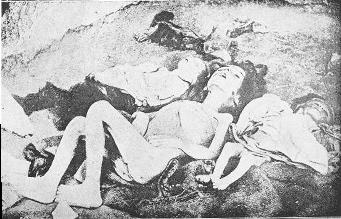 |
|
A starved mother
with her two starved children |
|
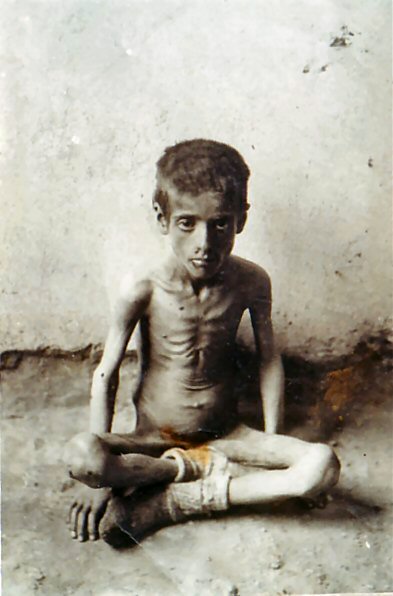 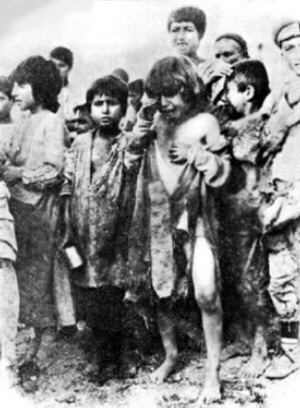 |
|
Armenian
Orphans |
Muslim Turks who assumed instant ownership of everything quickly
occupied most of the homes and villages left behind by the rousted
Armenians. In many cases, local Turks who took them from their
families spared young Armenian children from deportation. The
children were coerced into denouncing Christianity and becoming
Muslims, and were then given new Turkish names. For Armenian boys
the forced conversion meant they each had to endure painful
circumcision as required by Islamic custom.
Turkish gendarmes escorted individual caravans consisting of
thousands of deported Armenians. These guards allowed roving
government units of hardened criminals known as the "Special
Organization" to attack the defenseless people, killing anyone they
pleased. They also encouraged Kurdish bandits to raid the caravans
and steal anything they wanted. In addition, an extraordinary amount
of sexual abuse and rape of girls and young women occurred at the
hands of the Special Organization and Kurdish bandits. Most of the
attractive young females were kidnapped for a life of involuntary
servitude.
The death marches during the Armenian Genocide, involving over a
million Armenians, covered hundreds of miles and lasted months.
Indirect routes through mountains and wilderness areas were
deliberately chosen in order to prolong the ordeal and to keep the
caravans away from Turkish villages.
Food supplies being carried by the people quickly ran out and they
were usually denied further food or water. Anyone stopping to rest
or lagging behind the caravan was mercilessly beaten until they
rejoined the march. If they couldn't continue they were shot. A
common practice was to force all of the people in the caravan to
remove every stitch of clothing and have them resume the march in
the nude under the scorching sun until they dropped dead by the
roadside from exhaustion and dehydration.
An estimated 75 percent of the Armenians on these marches perished,
especially children and the elderly. Those who survived the ordeal
were herded into the desert without a drop of water. Being thrown
off cliffs, burned alive, or drowned in rivers.
|
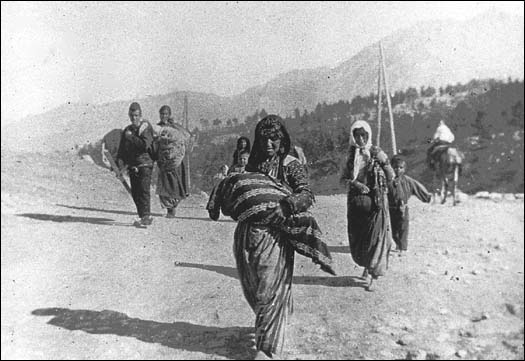 |
|
Armenian deportees walking |
During the Armenian Genocide, the Turkish countryside became
littered with decomposing corpses. At one point, Mehmed Talaat
responded to the problem by sending a coded message to all
provincial leaders: "I have been advised that in certain areas
unburied corpses are still to be seen. I ask you to issue the
strictest instructions so that the corpses and their debris in your
vilayet are buried."
But his instructions were generally ignored. Those involved in the
mass murder showed little interest in stopping to dig graves. The
roadside corpses and emaciated deportees were a shocking sight to
foreigners working in Turkey. Eyewitnesses included German
government liaisons, American missionaries, and U.S. diplomats
stationed in the country.
During the Armenian Genocide, the Christian missionaries were often
threatened with death and were unable to help the people. Diplomats
from the still neutral United States communicated their blunt
assessments of the ongoing government actions. U.S. ambassador to
Turkey, Henry Morgenthau, reported to Washington: "When the Turkish
authorities gave the orders for these deportations, they were merely
giving the death warrant to a whole race..."
The Allied Powers (Great Britain, France, Russia) responded to news
of the massacres by issuing a warning to Turkey: "...the Allied
governments announce publicly...that they will hold all the members
of the Ottoman Government, as well as such of their agents as are
implicated, personally responsible for such matters."
The warning had no effect. Newspapers in the West including the New
York Times published reports of the continuing deportations with the
headlines: Armenians Are Sent to Perish in the Desert - Turks
Accused of Plan to Exterminate Whole Population (August 18, 1915) -
Million Armenians Killed or in Exile - American Committee on Relief
Says Victims of Turks Are Steadily Increasing - Policy of
Extermination (December 15, 1915).
In 1918, the Armenians
managed to acquire weapons and they fought back, finally repelling
the Turkish invasion at the battle of Sardarabad, thus saving the
remaining population from total extermination with no help from the
outside world. Following that victory, Armenian leaders declared the
establishment of the independent Republic of Armenia.
Turkey's Continuous Denial:
The Turkish denial in the
past several decades of this
evil Genocide is interesting, yet not unexpected since Islam itself
is a religion of
denial and lies. The Turks forget that they themselves have confessed in
earlier times.
Turkish Prime Minister
Damat Ferid Pasha placed the blame squarely on the Young Turk Party.
Mustafa Kemal Pasha {Ataturk} said {in a 1926 interview with a Swiss
reporter that} the Young Turks "should be made to account for the
lives of millions of our Christian subjects who were ruthlessly
driven en masse from their homes and massacred. . . ."
The Armenian Genocide
was witnessed by hundreds of American missionaries in the Ottoman
Empire but especially in Anatolia, which was the traditional
Armenian homeland. These missionaries worked among the
Armenians and have testified to their destruction by the Ottoman
government.
The Genocide was also witnessed by American and European consular
officials, stationed in the areas inhabited by the Armenians, who
reported it to the ambassadors in Istanbul. Also, there were indeed
with many European military advisers with important posts in the
Turkish army at the time.
The American Ambassador to the Ottoman Empire, Henry Morgenthau,
Sr., confronted the Young Turk leaders, and then he telegraphed the
American Secretary of State calling the Turkish action an attempt at
"racial extermination."
The Armenian Genocide
was well-reported in the American press, and the U.S. Senate held
hearing which affirmed its reality.
President Woodrow Wilson agreed to draw the boundaries of a free
Armenia and sent a message to Congress asking for permission to
establish a U.S. mandate over the new state.
[I ask this] "Not only because it [the mandate] embodied my own
convictions and feeling with regard to Armenia and its people, but
also, and more particularly, because it seemed to me to be the voice
of the American people expressing their deep sympathies. At their
hearts, this great and generous people [the Americans] have made the
case of Armenia their own.
The American people raised millions of dollars to aid the victims of
the Genocide. Our older citizens will remember aid to the "starving
Armenians."
President Herbert Hoover wrote in his Memoirs:
Probably Armenian
was known to the American school child in 1919 only a little
less than England ... of the staunch Christians who were
massacred periodically by the Mohammedian Turk, and the Sunday
School collections of over fifty years for alleviating their
miseries. . . .
|
|
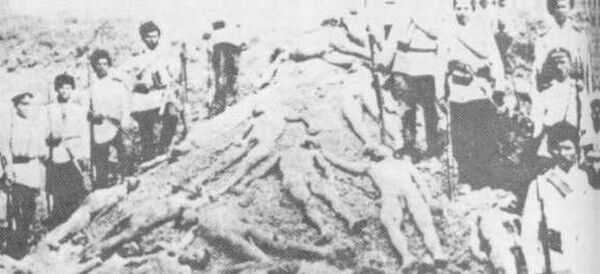 |
|
Turkish soldiers proudly posing with
bodies of their Christian victims.
To these
Muslims, the "Christians were like animals to
be hunted." |
The Hellenic & Armenian Genocide was the systematic
torture, massacre and ethnic cleansing of
several millions Hellenes (Greeks)
and Armenians perpetrated by the Turks in Asia Minor,
Constantinople (called Istanbul by the Turks),
Eastern Thrace, Imvros, Tenedos, Macedonia,
Cappadocia and Pontos between the beginning of
the 1890's and the end of the 1950's.
Millions of children, men and women were
tortured and massacred or expelled from their
homes only for being Hellenes. In the same
places and often at the same time, were also
massacred millions of Armenians and
Assyrians.
The only "sin" of those millions of persons was
to live where their ancestors had lived for
thousands of years before the Turkish
invasions. The Turkish rulers carried out
with unimaginable cruelty their plan to create a
"Turkey for the Turks."
|
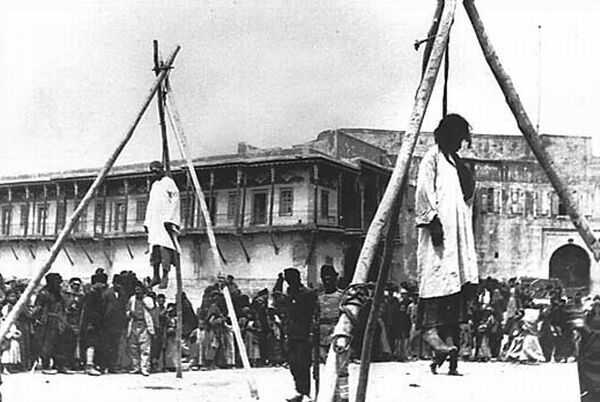 |
|
April 24th 1915, is commemorated
worldwide by Armenians as Genocide
Memorial Day, when hundreds of
Armenian leaders were murdered in
Istanbul after being summoned and
gathered. |
"The
fall of Abdul Hamid had been made
possible by the cooperation and aid
of the Christians. But the latter —
Greeks, Bulgars, Serbs — were soon
cruelly disillusioned. A general
persecution was started, the details
of which were reported to their
various governments by all the
consuls of the city. This
persecution first displayed itself
in the form of sporadic murders of
alarming frequency all over
Macedonia, the victims being, in the
beginning, notables of the various
Christian communities. A favorite
place for shooting these people was
at their doorsteps at the moment of
their return home. It became evident
that the Turkish Government, in
order to gain control of the
territory, was bent upon the
extermination of the non-Mussulman
leaders. Many of those murdered had
been prominent in the anti-Abdul
movement." |
| |
U.S.
ambassador to Turkey, Henry Morgenthau's
says;
"And
for centuries the Turks simply lived like parasites
upon these overburdened and industrious people. They
taxed them to economic extinction, stole their most
beautiful daughters and forced them into their
harems, took Christian male infants by the hundreds
of thousands and brought them up as Moslem soldiers.
I have no intention of describing the terrible
vassalage and oppression that went on for five
centuries; my purpose is merely to emphasize this
innate attitude of the Moslem Turk to people not of
his own race and religion---that they are not human
beings with rights, but merely chattels, which may
be permitted to live when they promote the interest
of their masters, but which may be pitilessly
destroyed when they have ceased to be useful. This
attitude is intensified by a total disregard for
human life and an intense delight in inflicting
physical human suffering which are not unusually the
qualities of primitive peoples."
President Grover Cleveland:
On
December 2, 1895 President Grover Cleveland wrote in
his Seventh Annual Message to Congress:
"Occurrences in Turkey have continued to excite
concern. The reported massacres of Christians
in Armenia and the development there and in other
districts of a spirit of fanatic hostility to
Christian influences naturally excited apprehension
for the safety of the devoted men and women who, as
dependents of the foreign missionary societies of
the United States, reside in Turkey under the
guarantee law and usage and in the legitimate
performance of their educational and religious
mission."
President Grover Cleveland addressed the problem of
Turkey's wicked treatment of its minorities and
subjects in his Eighth Annual Message on December
7th, 1896. In that address to Congress he said about
Turkey:
"we
have been afflicted by continued and not infrequent
reports of the wanton destruction of homes and the
bloody butchery of men, women and children, made
martyrs to their profession of Christian faith."
Theodore Roosevelt on the Armenian Holocaust:
In his
book "Fear God and Take Your Own Part" (NY, George
H. Doran Co, 1916), Theodore Roosevelt wrote:
"Armenians, who for some centuries have sedulously
avoided militarism and war, and have practically
applied advanced pacifist principles...and they are
so suffering precisely and exactly because they have
been pacifists whereas their neighbors, the Turks,
have not been pacifists but militarists." Page 61
"During the last year and a half...unoffending,
industrious and law abiding peoples like the
Armenians, have been subject to wrongs far greater
than any that have been committed since the close of
the Napoleonic Wars...and, indeed, in the case of
the Armenians, the wars of Genghis Khan and
Tamerlane in Asia." Page 111
|
|
Treaty of Sevres
8/10/1920 |
|
Woodrow Wilson on the Armenian Holocaust:
In
recognition of the Armenian holocaust, in the last
major endeavor before he died, U.S. President
Woodrow Wilson's Treaty of Sevres was intended by
him to provide protection for the Armenians.
Congress had earlier discussed making Armenia a U.S.
protected country like the Virgin Islands, Guam and
Puerto Rico. In his special message to
Congress Woodrow Wilson stated:
|
Whereas the testimony adduced at the
hearings conducted by the subcommittee
of the Senate Committee on Foreign
Relations have clearly established the
truth of the reported massacres and
other atrocities from which the Armenian
people have suffered; and
Whereas the people of the United States
are deeply impressed by the deplorable
conditions of insecurity, starvation,
and misery now prevalent in Armenia.... |
|
|
In the
early 1800's, President John Quincy Adams commented
on the fate of Christians in Muslim lands (John
Quincy Adams, "Essays on Turks", page 303):
"Those
provinces are the abode of ten millions of human
beings, two thirds of whom are Christians, groaning
under the intolerable oppression of less than three
million Turks. Those provinces are in some of
the fairest regions of the earth.
They
were Christian countries, subdued during the
conquering period of the Mahometan imposture, by the
ruthless scymetar of the Ottoman race; and under
their iron yoke, have been gradually dwindling in
population, and sinking into barbarism.
Time
of their redemption is at hand."
Below
is what he wrote regarding treaties with Muslims
(John Quincy Adams, "Essays on Turks", pages
274-275), which is something Presidents Carter to
the present George Bush have not been able to
comprehend:
"The
victorious may be appeased by a false and delusive
promise of peace and the faithful follower of the
prophet may submit to the imperious necessities of
defeat, but the command to propagate the Moslem
creed by the sword is always obligatory when it can
be made effective...The commands of the prophet may
be performed alike, by fraud or by force. Of
Mahometan good faith, we have as memorable examples
ourselves.... Such is the spirit, which governs the
hearts of men, to whom treachery and violence are
taught as principles of religion." |
|
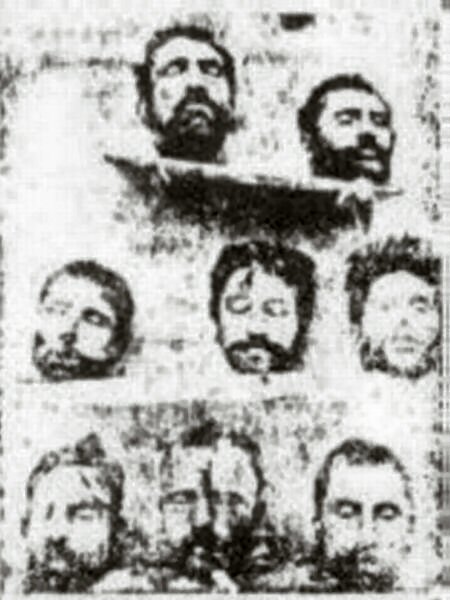 |
|
Heads of Christians, traditionally treated like trophies
by the Turks. |
|
